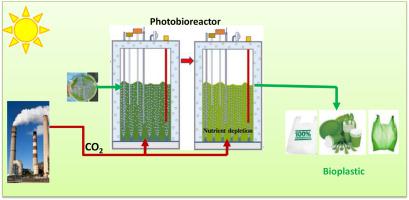Journal of Environmental Chemical Engineering ( IF 7.4 ) Pub Date : 2021-03-21 , DOI: 10.1016/j.jece.2021.105379 Yashavanth P R. , Meenakshi Das , Soumen K. Maiti

|
Plastic plays a crucial role in the household, industrial, and healthcare sectors and has become an integral part of human civilization. The non-biodegradable nature of plastic leads to severe environmental hazards. Therefore, an eco-friendly bioplastic such as polyhydroxybutyrate (PHB) has the potential to replace conventional plastics. PHB from bacteria is very expensive due to the use of costly sugar in the fermentation process. Photosynthetic prokaryotes, cyanobacteria can produce PHB intracellularly, store it as carbon and energy source using sunlight and CO2. Cyanobacterial PHB is of superior quality compared with other prokaryotes. Many wild-types and genetically modified cyanobacteria show PHB accumulation under optimized conditions on the lab-scale, but only a few studies had reported large-scale PHB production. This review has explored the advances in upstream and downstream processing strategies for PHB production from cyanobacteria. Challenges associated with process optimization and strain development for industrial-scale PHB production and commercialization of bioplastic have also been discussed here.
中文翻译:

蓝细菌自养生产生物塑料聚羟基丁酸酯(PHB)的最新进展和挑战
塑料在家庭,工业和医疗保健领域起着至关重要的作用,已经成为人类文明的组成部分。塑料的不可生物降解特性会导致严重的环境危害。因此,诸如聚羟基丁酸酯(PHB)的生态友好型生物塑料具有替代常规塑料的潜力。由于在发酵过程中使用了昂贵的糖,因此细菌产生的PHB非常昂贵。光合原核生物,蓝细菌可在细胞内产生PHB,并利用阳光和CO 2将其作为碳和能源储存。与其他原核生物相比,蓝细菌PHB的质量更高。许多野生型和转基因蓝细菌在实验室规模的最佳条件下显示PHB积累,但是只有少数研究报道了大规模PHB的生产。这篇综述探讨了从蓝细菌生产PHB的上游和下游加工策略的进展。本文还讨论了与工业规模PHB生产和生物塑料商业化相关的工艺优化和菌株开发相关的挑战。











































 京公网安备 11010802027423号
京公网安备 11010802027423号